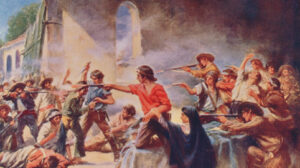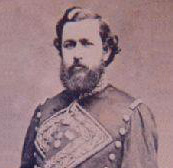
Credit: Library of Congress, Prints and Photographs Division, created by Percy Moran 1912. Copyright by
Gerlach Barklow Co., Joliet, Illinois.
Soon after Texas won independence from Mexico in 1836, the state legalized slaveryan extreme form of human oppression whereby an individual may "own" another person and the... More. Free blacks and mulattoes were forbidden from entering Texas, which had once been a safe haven for runaways. In the 1830s, as the westward push of white settlements and of slavery brought significant numbers of new settlers into the region, conflicts between whites and Mexicans, who had long occupied the land, increased. In Texas, authorities used the Texas Rangers to protect the large land and cattle operations established after statehood from insurgents li e Juan Cortina, a wealthy Mexican-born rancher who became a symbola sign or attribute that stands for something else, to which it may or may... More of militant resistance to Anglo racismthe use of race to establish and justify a social hierarchy and system of power... More. Authorities in Texas systematically disenfranchised Mexican Americans, and prevented them from serving in local government, while vigilantes, with broad support from the white communities, terrorized Mexican Americans in southern Texas, where they were most numerous. Statehood was delayed for New Mexico, primarily because of its Mexican American political leadership, however Mexican Americans remained the majority population until the end of the nineteenth century.
- In 1829, Mexico abolished slavery and became a refuge for runaways.
- In 1839, Africans aboard the Spanish slave ship Amistad mutinied. When the ship landed off the coast of Long Island, they pleaded for freedom in the courts. Two years later, in 1841, the U.S. Supreme Court declared the Amistad slaves free.
- In 1840, South Carolina enacted a “black code,” in which slaves were denied basic rights, such as the freedom to assemble, produce food, earn money, learn to read or possess anything other than low-quality clothing.
- In 1848, the Treaty of Guadalupe Hidalgo ended the Mexican American War, ceding large portions of what are now Colorado, Arizona, New Mexico, Wyoming, California, Nevada and Utah to the U.S. in return for $15 million and relief from debt. The treaty was supposed to protect the existing civil rights and land claims of Mexican citizens and provide full American citizenship to those who stayed in the newly ceded territories. However, the U.S. Senate’s ratification of the treaty deleted the guaranteed land rights and citizenship.
- The 1850 censusAn official count of a population and collection of demographic data. The United States Census... More was the first to distinguish between native and non-native born Americans. New York City was more than half foreign born; high proportions of foreign born were found in Chicago, Milwaukee, Detroit, St. Louis, and New Orleans. Political forces in the U.S. were strongly anti-immigration, but economic concerns prevailed and immigrationthe act of entering a country of which one is not a native to become... More continued. Anti-immigration forces created internal barriers by differentially granting civil rights, and used the census for this purpose.
- By the mid-1800s Chinese immigrants came to the West Coast, drawn to railroad and mine work.
Related Posts

Source: Wikipedia.org
… These have connived with each other…to persecute and rob us, without any cause, and for no other crime on our part than that of being of Mexican origin…
– Juan Nepomuceno Cortina Goseacochea, also known as Juan Cortina
Juan Nepomuceno Cortina Goseacochea, a wealthy Mexican cattle rancher also known as Juan Cortina, fought in the Mexican Army during the Mexican-American War. Following the war, Cortina and fellow Mexican Texan (Tejanos) ranchers found that the large portions of their land in the Rio Grande Valley were now within U.S. borders. As local white authorities tried to appropriate their land, Cortina organized a private army of Tejanos to resist eviction from their land. His battles against the U.S. Army, the Texas Rangers and the local militia of Brownsville, Texas, were known as the Cortina Troubles.




